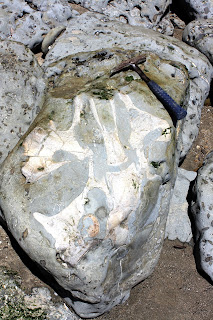Carcharodon hastalis tooth collected by Sarah from the lower Purisima Formation; teeth from this spot are often missing the root.
Pigeon guillemots roosting in exposures of the Santa Cruz Mudstone near Natural Bridges State Beach - one of the best sightings I've had of these guys!
Pigeon guillemot coming in for a landing over Monterey Bay.
Pigeon guillemots are members of the family Alcidae, the group including murres, auks, and puffins.
A medium-sized sperm whale tooth from the Purisima Formation! I was particularly happy about this find.
A skull of "Balaenoptera" portisi, from the Purisima Formation and on display below the mounted blue whale at the Long Marine Lab in Santa Cruz.
The remains of the middle of a balaenopterid (rorqual) skull destroyed when somebody inadvertently chopped through it cutting surfer's stairs into the cliffs.
Beautiful view of the Santa Cruz coastline.
Bonebed 5 from my master's thesis/PLoS One article, showing fissure fill in a large burrow likely formed by a large boring pholad clam.
In Capitola there is an entire retaining wall constructed from blocks of concretions from the beach (mostly bonebed 6 of my PLoS One paper), but in one spot a caudal vertebra of a baleen whale was carefully chosen to be placed as a building stone...
At Capitola, beautiful invertebrates are exposed - hundreds of thousands of shells - including these large cockles, Clinocardium meekianum.
Here's a smaller nodule containing a collection of partially associated/articulated Clinocardium meekianum.
Elsewhere shellbeds are not quite so concreted - here sandy bottom bivalves (Anadara, Macoma) form beautiful lenses, pavements, and stringers within beautifully colored "blue sandstones".
But vertebrates are what I really care about! Here's a nice lumbar vertebra of a dolphin, in a large chunk of concretion that makes it not worth the effort to haul it off the beach.
I first spotted this skull in 2009, and after three years of erosion while living in New Zealand I can finally identify it as the tip of a baleen whale palate - possibly Herpetocetus.
And here's a small balaenopterid whale skull which I first spotted back in 2002. We're looking at the bottom of the skull...
...and here's a closeup of the auditory bones, in particular the curly looking orange element, which is the tympanic bulla. It's possible that this is an early gray whale, but unless the impossibly hard matrix was cleaned off (after removal of the impossibly heavy block, of course) we'll probably never know.
This is for certain a new Herpetocetus skull - mostly embedded in impossibly hard concretionary matrix.
And this is also a Herpetocetus braincase, one which I first came across back in 2008 or so while on a visit with Sarah (girlfriend at the time).
Ten years later, and she's still sleeping on the job.





















No comments:
Post a Comment